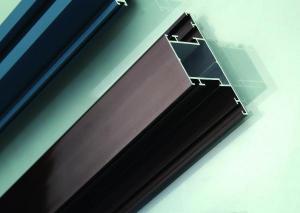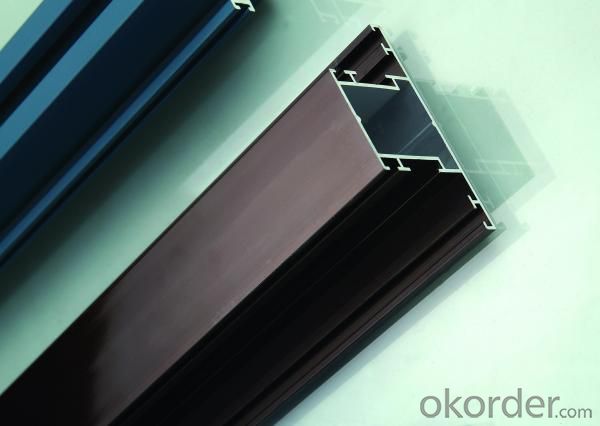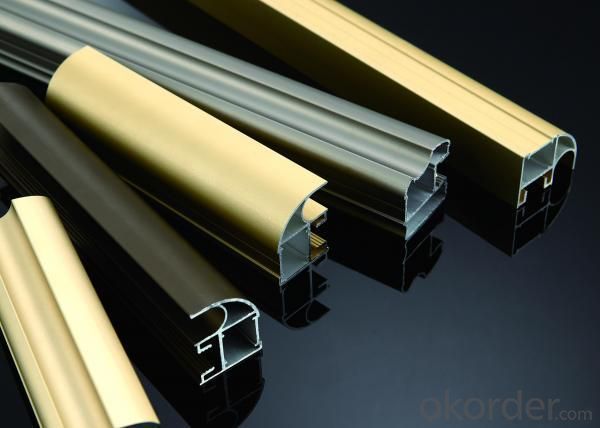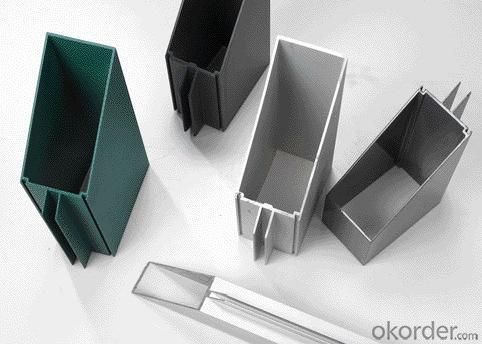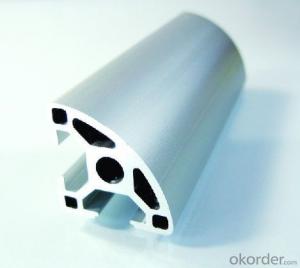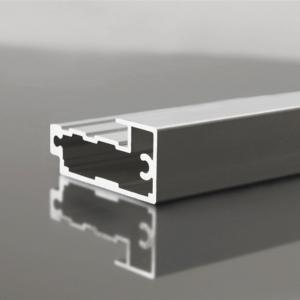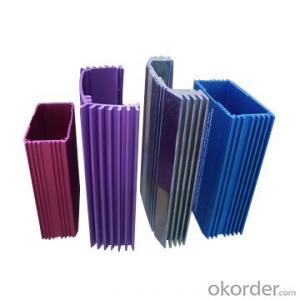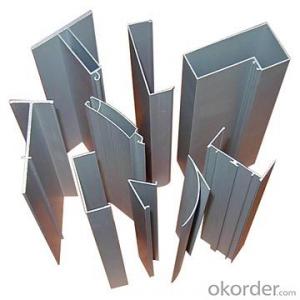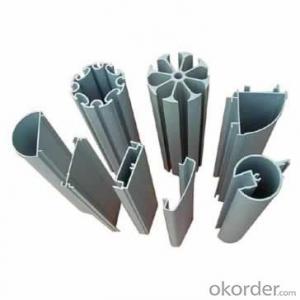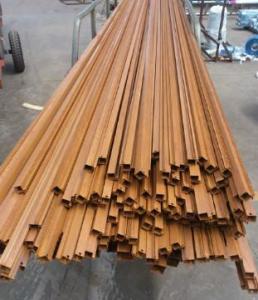T Slot Aluminum Profiles 6463-T5
- Loading Port:
- ShenZhen
- Payment Terms:
- TT or LC
- Min Order Qty:
- 10MT m.t.
- Supply Capability:
- 1000 Tons Per Month m.t./month
OKorder Service Pledge
OKorder Financial Service
You Might Also Like
1 Specifications of Aluminum Profiles 6463
Alloy Number | 6063 6061 6060 and different aluminium alloy |
Temper | T4 T5 T6 or other special status |
Surface available | Mill finish, Anodized, Powder Coating, Wooden transfering, electrophoresis, heat insulation, PVDF, and deep processing |
Thickness: | >0.8mm |
Width: | <300mm |
Standard | GB5237.1-2008 |
Special Specification is available on customer’s requirement
2 Usage/Applications of Aluminum Profiles 6463
Aluminium Profiles are widely used in construction(windows & doors,curtain wall), decoration ( flooring and tiling, kitchen) and industry ( heat sink ).
CNBM produces aluminum profiles which meets the national standard GB5237.1-2008. Our strong quality control term bring you the most-qualified products. And with state-of-the-art equipment, and the state owned company background, we have to say, you will understand why there are so many company choose CNBM to be their supplier.
3 Packaging & Delivery of Aluminum Profiles 6463
Packaging: Seaworthy package, bubble plastic bag inside, anti-moisture paper wrapped outside, covered with cartons, on wooden pallets, in containers.
Shipment: the goods will be delivered in 15-30days after getting the buyer's payment.
4 Production Flow of Aluminum Profiles 6463
aluminium ingot & alloy→melting and casting→extrusion→powder coating→pouring rubber for heat insulation→checkout→packing→PVDF coating\anodizing\electrophoresis→put in products warehouse.

- Q: The surface of pure aluminum is relatively soft, too hard to be machined, and the other to be polished. If you want to harden the aluminum parts you produce. What's the way?. Please expert pointing
- 6063 is not pure aluminum, in order to harden can consider aging, I used to do aluminum profile, mainly through air-cooled quenching and aging to achieve T5 processing
- Q: Can aluminum profiles be used in transportation and logistics applications?
- Aluminum profiles find common usage in transportation and logistics applications, owing to their lightweight yet robust nature. This makes them an ideal choice for various components in the industry. Within the automotive sector, aluminum profiles are employed in the production of car frames, chassis, and body panels. Their lightweight quality aids in reducing vehicle weight, leading to enhanced fuel efficiency and lower emissions. Moreover, aluminum profiles exhibit excellent resistance to corrosion, ensuring vehicle longevity even in harsh environmental conditions. The aerospace industry heavily relies on aluminum profiles for the construction of aircraft structures, including wings, fuselage, and landing gear. The high strength-to-weight ratio of these profiles allows for increased payload capacity and improved fuel efficiency. Furthermore, aluminum profiles can withstand extreme temperature fluctuations and possess good electrical conductivity, rendering them suitable for diverse aerospace applications. In the logistics sector, aluminum profiles are utilized in the creation of cargo containers, pallets, and storage racks. Their lightweight nature facilitates easy handling and transportation of goods. Additionally, these profiles offer high resistance to rust and corrosion, ensuring the durability of logistics equipment, even in humid or corrosive environments. Moreover, aluminum profiles can be easily customized and fabricated to meet specific design requirements in transportation and logistics applications. Their extrudability into various shapes and sizes allows for versatility in design and functionality. Furthermore, aluminum profiles offer flexibility in assembly and maintenance, as they can be joined using different methods like welding or fastening. To sum up, the lightweight, strong, corrosion-resistant, and versatile properties of aluminum profiles make them highly suitable for transportation and logistics applications. They confer various benefits, such as improved fuel efficiency, increased payload capacity, and durability in harsh environments. Consequently, aluminum profiles find extensive use in the automotive, aerospace, and logistics industries for various components, thereby contributing to the efficiency and reliability of transportation and logistics systems.
- Q: The question asks if aluminum profiles can be tailored to fit particular specifications or needs.
- <p>Yes, aluminum profiles can be customized to meet specific requirements. This customization can include altering the length, shape, thickness, and surface treatment of the profiles to fit the needs of various applications. Manufacturers often offer a range of standard sizes and finishes, but they can also create bespoke profiles through processes like extrusion, cutting, and bending. Customization allows for the creation of precise fits and functional designs tailored to individual projects, enhancing both aesthetics and performance.</p>
- Q: Are aluminum profiles suitable for automotive body panels?
- Yes, aluminum profiles are suitable for automotive body panels. Aluminum is a lightweight and strong material, making it ideal for improving fuel efficiency and enhancing overall vehicle performance. Additionally, aluminum profiles offer excellent corrosion resistance, durability, and design flexibility, making them a popular choice for modern automotive applications.
- Q: Can aluminum profiles be used in HVAC systems?
- HVAC systems can utilize aluminum profiles, which are lightweight and durable materials commonly found in various industries. Aluminum profiles offer numerous advantages, including excellent thermal conductivity, resistance to corrosion, and easy malleability. In HVAC systems, aluminum profiles are frequently employed for various components such as ductwork, air vents, and heat exchangers. The ductwork made from aluminum profiles is lightweight, easy to install, and resistant to corrosion. Consequently, it has become a popular choice for HVAC installations. Aluminum air vents facilitate efficient airflow and can be effortlessly adjusted to control the direction and volume of air. Furthermore, aluminum heat exchangers are extensively used in HVAC systems. The exceptional thermal conductivity of aluminum allows for efficient heat transfer, making it an ideal material for applications that necessitate heat exchange. Additionally, the corrosion resistance of aluminum ensures the longevity and dependability of heat exchangers, even in harsh environments. In conclusion, due to their lightweight nature, durability, thermal conductivity, and corrosion resistance, aluminum profiles are an appropriate choice for HVAC systems. They enhance the overall efficiency and performance of HVAC systems while guaranteeing long-lasting functionality.
- Q: Can aluminum profiles be used for exhibition booths?
- Yes, aluminum profiles can be used for exhibition booths. Aluminum profiles are lightweight, durable, and easy to assemble, making them a popular choice for constructing exhibition booths. They can be easily customized to fit specific design requirements and can be used to create walls, frames, and structures for displaying products and promotional materials. Additionally, aluminum profiles can be easily transported and stored, making them a practical choice for exhibition booths that need to be set up and dismantled multiple times. Overall, aluminum profiles offer versatility and convenience in creating visually appealing and functional exhibition booths.
- Q: How do aluminum profiles perform in terms of electrical conductivity?
- Compared to metals like copper or silver, aluminum profiles exhibit relatively lower electrical conductivity. This discrepancy arises from aluminum's higher resistivity, which results in increased resistance to the flow of electric current. Nevertheless, aluminum profiles retain adequate electrical conductivity for numerous applications. They effectively facilitate the conduction of electricity, rendering them appropriate for diverse electrical and electronic devices. Moreover, if necessary, aluminum profiles can undergo specific treatments or coatings to further enhance their conductivity.
- Q: How do aluminum profiles perform in terms of chemical resistance?
- Aluminum profiles exhibit good chemical resistance to many common substances, including water, air, various acids, and alkalis. However, they may corrode or react with certain aggressive chemicals, such as strong acids or bases. It is important to consider the specific chemical environment and consult relevant guidelines or experts when assessing the chemical resistance of aluminum profiles.
- Q: This question asks if aluminum profiles can be utilized in the construction of environmentally friendly buildings.
- <p>Yes, aluminum profiles can be used for green building applications. They are valued for their durability, recyclability, and energy efficiency. Aluminum is lightweight, which reduces the building's carbon footprint during transportation. It also has excellent thermal conductivity, allowing for better insulation and energy conservation. Additionally, aluminum can be recycled without losing its properties, contributing to a circular economy and reducing waste. These characteristics make aluminum profiles suitable for sustainable construction practices.</p>
- Q: Are aluminum profiles suitable for balcony railings?
- Indeed, balcony railings can be effectively made using aluminum profiles. Aluminum is a favored material for balcony railings because it possesses qualities such as resilience, robustness, and minimal upkeep requirements. Its resistance to rust and corrosion makes it exceedingly appropriate for outdoor applications. Moreover, aluminum profiles can be effortlessly tailored and molded to match any desired design or architectural style. Although lightweight, they offer ample strength to ensure necessary support and safety for balcony railings. Additionally, aluminum railings are obtainable in a plethora of finishes and colors, providing limitless possibilities for design. On the whole, aluminum profiles are a dependable and fashionable choice for balcony railings.
1. Manufacturer Overview
| Location | Guangdong, China |
| Year Established | 1991 |
| Annual Output Value | Above US$50 Million |
| Main Markets | Mid East;Eastern Europe;North America |
| Company Certifications | ISO 9001:2000;ISO 14001:2004;OHSAS 18001 |
2. Manufacturer Certificates
| a) Certification Name | |
| Range | |
| Reference | |
| Validity Period |
3. Manufacturer Capability
| a) Trade Capacity | |
| Nearest Port | Nanhai Port |
| Export Percentage | 30%-50% |
| No.of Employees in Trade Department | 21-50 People |
| Language Spoken: | English;Chinese |
| b) Factory Information | |
| Factory Size: | Above 100,000 square meters |
| No. of Production Lines | Above 10 |
| Contract Manufacturing | OEM Service Offered;Design Service Offered |
| Product Price Range | Average |
Send your message to us
T Slot Aluminum Profiles 6463-T5
- Loading Port:
- ShenZhen
- Payment Terms:
- TT or LC
- Min Order Qty:
- 10MT m.t.
- Supply Capability:
- 1000 Tons Per Month m.t./month
OKorder Service Pledge
OKorder Financial Service
Similar products
Hot products
Hot Searches
Related keywords

